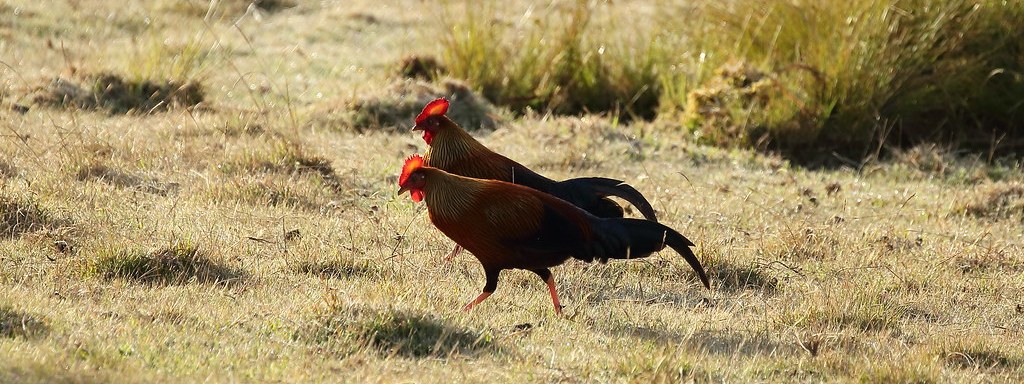REGION
DURATION
AREAS
TOUR SUMMARY
Sri Lanka
08 Days/ 07 Nights
Colombo Bandaranaike International Airport – Kitulgala – Nuwara Eliya – Horton Plains National Park – Embilipitiya Sinharaja – Colombo Airport
ITINERARY
Please feel free to ask for a customised Trip.
KITULGALA
The drive to Kitulgala is about four hours from the hotel in Colombo and would take us through lush wet zone home gardens containing small scale spices, cultivations, rubber plantations, over perennial rivers and streams. This journey is your first glimpse into the wet zone of the country and its people whose life style and livelihood which is in contrast to what you’d witness later on. Kitulgala is in the vicinity of the film location of the classic “Bridge over river Kwai”. We check into to the rest house located beside the River Kalani which is fascinating. Villages use a dugout canoe with an outrigger unique to the island, for ferrying across the river. We will use this same mode of transport in order get across for our evening session of birding in Kitulgala Forest or Kelani Valley Forest Reserve. It is low country rainforest containing a host of endemic birds and other wildlife unique to the Island. Some of the birds are found around home gardens and will be a fascinating experience. Two of the most sorts after endemics are the Chestnut-backed Owlet for which we will head in the direction to a known stakeout of it. Discovery of the latter owl by one of our tour leaders created a sensation in the birding world in 2001. Other endemic birds found here is the Yellow-fronted Barbet, Sri Lanka Spurfowl, Green-billed Coucal, Red-faced Malkoha, Sri Lanka Hanging Parrot, Layard’s Parakeet, Spot-winged Thrush, Orange-billed Babbler and Sri Lanka Blue Magpie to name a few.
Overnight stay at Kitulgala Rest House or similar hotel.
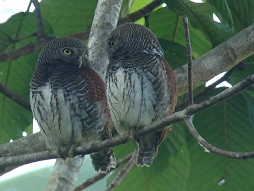
Chestnut-Backed Owlet
KITULGALA
Today we spend more time seeking species missed out yesterday and may also venture out into localities we did not visit yesterday looking for target birds, which will too give us a chance to get a better idea of the village culture. We will also look out for other subcontinent endemics such as Malabar Trogon, Ceylon Frogmouth, Indian Pitta, etc. Kitulgala Forest Reserve holds a myriad of Butterflies, Amphibians and Reptiles, we would not pursue in search of them unless it is necessary but as and when sightings of these animals occur.
Overnight stay at Kitulgala Rest House or similar hotel.
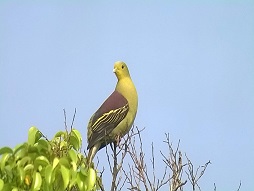
Sri Lanka Green Pigeon
KITULGALA - NUWARA ELIYA
Nuwara Eliya is a well known hill station during the British Raj and climatic conditions here is a total contrast from the lowlands so is the terrain and lifestyle of the people. The drive is approximately four hours but with regular stops, this could take a little longer. Off all the drives up to now, this probably would be the most picturesque, as it would take us through lush tea plantations, what the country inherited from the British. The architecture of some buildings goes back to the colonial era, so is the gardens.
After lunch we head in the direction of the Victoria Park in the town, a well known site amongst birders world over for some subcontinental specialities migrating from the Himalayan foothills. This is probably the best location anywhere in the world to see them. It is well known that the majority of Kashmir Flycatchers migrate in winter to this part of Sri Lanka, even in their breeding areas in Kashmir it’s known to be difficult observing these birds thus many birders visit this park in order to tick this species. Another interesting bird is the Pied Ground Thrush, once again a difficult bird in its breeding area. This is also good site for migrating Indian Pitta, and the country’s hill endemics such as Yellow-eared Bulbul and Ceylon White-eye.
Overnight stay at Nuwara Eliya or similar hotel.
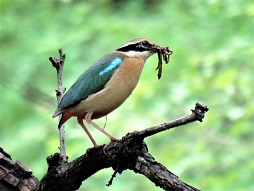
Indian Pitta
HORTON PLAINS NATIONAL PARK
Horton Plains were discovered during the colonial period by a hunting party and named after the governor of the Island and until recently was a popular tourist destination. Out of all days, today would be considerably an early one, as the drive to Horton Plains National Park is essentially important for a few reasons. Principle being seeing the elusive Ceylon Whistling-thrush, a bird on every birders wish list, also the best time to witness the beauty of the place is in the morning. We also look for endemic Ceylon Wood Pigeon, Ceylon Bush Warbler, Paid Thrush, and Dusky Blue Flycatcher amongst other hill birds. The forest type is mountain cloud forest and nowhere else could you see such a beautiful forest type so rich. The park consists of many endemic plant species and most vital being its Orchids. Apart from floral aspects the amphibians and reptiles found here are endemic too and second to no other place, the Rhino-horned Lizard resembles a denizen from the past. It is not rare encountering these creatures here. Smooth-coated Otter sometimes frequent the pools and streams found here and our venturing out here very early may give the chances of seeing this elusive mammal. The mornings also bring out large herds of Sambur a spectacle seldom seen elsewhere. We will return to Nuwara Eliya in time for lunch. And spend the evening at a few stakeouts for some target birds.
Overnight stay at Nuwara Eliya or similar hotel.

Serendib Scops-Owl
NUWARA ELIYA - EMBILIPITIYA
The observant traveller may witness the changing of three climatic zones as you descend gradually in to the low country. The changing life styles, industries and agriculture of the people is very interesting, if it is on a right day we may passing through a village trading fair. These trading fairs are very interesting as they would have varieties of vegetables little known elsewhere, grains, utensils used in cooking clothing footwear, and more. Usually Embilipitiya is the place where tourists base themselves in order to visit Udawalawe National Park.
On route we visit a site for Marshall’s Lora a sort after subcontinental endemic whose occurrence in the country was discovered very recently. The evening will be spent at a wetland where Bitterns, Watercock and other waterbirds are seen on a regular basis, after which we visit a site known to have White-naped Woodpecker.
The morning session we will visit Udawalawe National Park in jeeps. The Park has a reputation for harbouring a large stock of Asian Elephants. Also the Department of Wildlife Conservation’s Orphaned Wild Elephant Rehabilitation Centre is situated bordering the park at a different location from the park entrance.
As far as the birds are concerned the park consists of some interesting raptors. Crested Hawk-Eagle, Crested Serpent- Eagle, Black-shouldered Kite, Shikra, White-bellied Sea-Eagle and Grey-headed Fish-Eagle are regularly seen.
Montagu’s Harrier, Pallid Harrier, Booted Eagle, Shaheen Falcon a race of the peregrine are also recorded. For those birders more sort after species would be Orange-breasted Green Pigeon, Sirkeer Malkoha, Oriental Dwarf-Kingfisher, Malabar Pied-Hornbill, Yellow-fronted Pied-Woodpecker, and an array of other passerines to be included on their life lists. Also this is the best place to see migrating Blyth’s Pipit which presents a challenge in identification. Udawalawe NP would certainly be a delicacy for birders and wild elephant fanatics as well as those interested in butterflies.
Overnight stay at Embilipitiya or similar hotel.
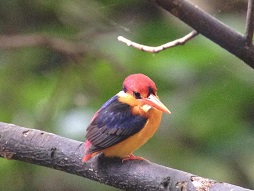
Oriental Dwarf Kingfisher
EMBILIPITIYA - SINHARAJA
After breakfast at the hotel we drive to Sinharaja. This drive is about three hours and we may encounter some birding opportunities on the way.
Overnight stay at Forest Lodge or similar hotel.
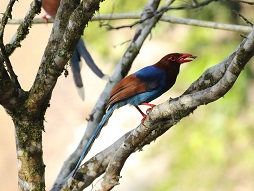
Sri Lanka Blue Magpie
SINHARAJA
Sinharaja Forest Reserves a must to any visitor to Sri Lanka for birding. Sinharaja is a tropical lowland rainforest and a renowned World Heritage Site. Its faunal and floral diversity is considered to be one of the highest in the world. Enthusiast world over visit this wonderful forest as it harbours a significant number of birds endemic to the island, furthermore insects, reptiles, plants and trees found here are unique to the island.
The chances of seeing the Red-faced Malkoha, Ceylon Blue Magpie, White-faced Starling, Ashy-headed Laughingthrush and Ceylon Scaly-Thrush are the highest here and would be hard to encounter elsewhere. The unique aspect here would be to come upon mixed species feeding flocks of birds (bird waves), up to twenty plus species could be observed including some Island and sub-continental endemics. The possibility of seeing some good raptors such as Serendib Scops-Owl, Black Eagle, Rufous-bellied Eagle, Crested Goshawk and Besra would be high on the agenda. The diversity of butterflies in Sinharaja is highest considering most sites we visited, thus we will use all opportunities depending on the interests for observing these wonderful creations of nature. Some of the more rare species we are bound to see would be the Blue Oakleaf, Five-bar Swordtail, Great Crow, and the Tree Nymph.
As for mammals, the dense Rainforests tends to keep them more elusive, but the Endemic Purple-faced Leaf Monkey and Ruddy Mongoose enters the tick lists regularly so is the endemic race of the Sri Lankan or Grizzled-tailed Giant Squirrel. The amphibian and reptile fauna is unique too with many species being peculiar to this forest alone, and many opportunities may arise where we will see them without any effort.
Overnight stay at Forest Lodge or similar hotel.
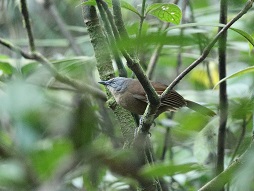
Ashy-headed Laughingthrush
DEPARTURE
We will spend morning in Sinharaja, thus maximising opportunities to see the splendour of this forest and its fauna. After lunch at the lodge we leave for a hotel near airport in Colombo for dinner and overnight stay, and for subsequent departures.
Our special thanks goes to Mrs. Tracey Graves for the images of the Sri Lanka Junglefowl, the Sri Lanka Blue Magpie and the Ashy- headed Laughingthrush.

